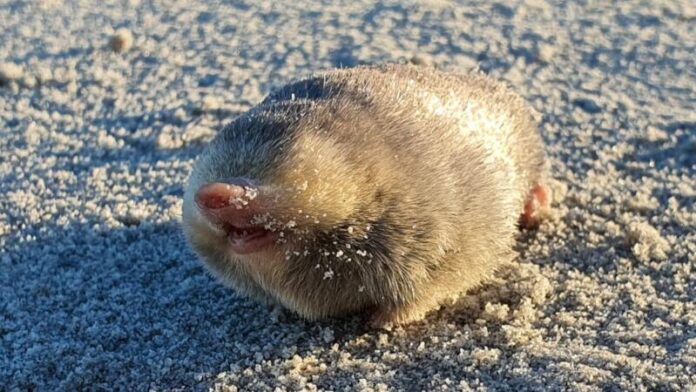Great news! A species of golden mole, believed to be extinct, has been rediscovered after over 80 years. The De Winton’s golden mole was last seen in 1937, and researchers have been searching extensively for it. Finally, the cute little creature was found in the sand dunes of South Africa. Unlike most moles that burrow deep in the soil, the golden mole lives in sand and swims through it, creating inaccessible caves where it resides.
The researchers began their quest to find the elusive golden mole by collecting over 100 samples of sand and analyzing them for environmental DNA (eDNA). This type of DNA is left behind by the animal in its environment through excretions, skin cells, and hair.
“We were fairly confident that if De Winton’s golden mole were in the environment, we would be able to detect it by finding and sequencing its DNA,” Samantha Mynhardt, a conservation geneticist with the Endangered Wildlife Trust (EWT) and Stellenbosch University in South Africa, said in a statement.
The De Winton’s golden mole is a very rare species that is only found in a small area called Port Nolloth, located on the Northwest coast of South Africa. However, since there are many other species of golden moles in this area, researchers had to find a way to distinguish them. They discovered fresh golden mole tracks and decided to use a specially trained sniffer dog to help them differentiate between the two most common golden moles in the area: the Cape golden mole (Chrysochloris asiatica) and Grant’s golden mole (Eremitalpa granti). When the dog did not react to the trail, it was a sign that it was a rarer golden mole.
After analyzing the DNA of 100 samples of sand in Port Nolloth, scientists found the DNA of two common golden moles along with two other sets of DNA. One of them was from the endangered Van Zyl’s golden mole (Cryptochloris zyli), while the other belonged to an unknown species. The scientists suspected that the DNA belonged to the extinct De Winton’s golden mole, but they couldn’t confirm it until they obtained a DNA sample from a De Winton’s golden mole specimen kept at the Iziko South African Museum in Cape Town. Upon studying the genes from the specimen, they confirmed that the unknown mole from the samples was indeed a De Winton’s golden mole.
Back from extinction
After their rediscovery, four more populations of De Winton’s golden mole have been discovered. Despite skepticism from some researchers, Cobus Theron, a senior conservation manager for EWT and member of the mole search team, always believed that the species had not yet gone extinct. He was convinced that it would just take the right detection method, proper timing, and a passionate team to find it.
Now that the mole has been found, it has opened up a new opportunity to use the eDNA frontier to find other lost or imperiled species. This is a significant discovery for the scientific community, and it highlights the importance of conservation efforts.
Not moles
Did you know that despite their name and appearance, golden moles such as De Winton’s golden mole are not actually moles? These insectivorous mammals are more closely related to otter shrews and tenrecs. However, due to a phenomenon known as evolutionary convergence, animals that are not closely related can share similar features. Like moles, golden moles have powerful claws for digging and spend most of their lives underground. They also have non-functional eyes, another trait shared with moles.

